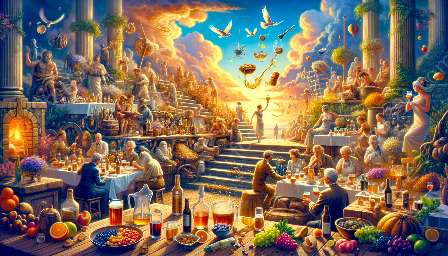Centuries ago, during the Renaissance period, a resurgence of cultural, artistic, and intellectual pursuits swept through Europe, transforming the way people lived, thought, and even what they drank. In this topic cluster, we will delve into the beverages that defined this remarkable era, their historical significance, and their impact on the study of beverages today.
The Renaissance Era: A Cultural and Intellectual Rebirth
The Renaissance, spanning roughly from the 14th to the 17th century, marked a period of immense cultural and intellectual growth. It was a time when the arts, science, and exploration flourished, and the exchange of ideas and knowledge revolutionized European society. This transformation also extended to the beverages of the time, as new flavors, techniques, and traditions shaped the drink culture of the Renaissance.
Wine: A Symbol of Status and Sophistication
During the Renaissance, wine was more than just a beverage; it was a symbol of social status and sophistication. The cultivation of vineyards and the production of wine flourished across Europe, and the nobility often flaunted their wealth and taste through extravagant displays of rare and fine wines. Italian and French wines, such as Chianti and Bordeaux, gained widespread popularity and became synonymous with luxury and refinement.
Wine and Art: A Fusion of Creativity and Culture
Artists of the Renaissance were captivated by the allure of wine, depicting scenes of conviviality, abundance, and indulgence in their works. Paintings and sculptures often featured wine as a central motif, celebrating the pleasures of the table and the conviviality of social gatherings. These artistic depictions not only reflected the prevalence of wine in Renaissance society but also influenced the cultural perception of beverages as an integral part of daily life.
Beer: Nourishment and Tradition
Beer, a staple beverage of the Renaissance, served as a source of nourishment and refreshment for people of all social classes. Brewed using grains such as barley and flavored with a variety of herbs and spices, beer held cultural significance as an everyday drink enjoyed by both urban dwellers and rural communities.
The Rise of Beer Culture: Local Brews and Traditions
Across Europe, diverse beer traditions and styles flourished, reflecting the unique local ingredients and brewing techniques of different regions. From the dark, malty ales of England to the crisp, aromatic lagers of Germany, beer became deeply embedded in the culinary and social fabric of Renaissance life, fostering a sense of community and identity.
Spices and Exotic Concoctions: A Taste of Exploration
The Age of Exploration during the Renaissance brought forth an array of exotic spices and ingredients from distant lands, igniting a culinary and beverage revolution in Europe. The introduction of spices such as cinnamon, nutmeg, and cloves enriched the flavors of beverages, inspiring the creation of exotic concoctions that captivated the palates of Renaissance drinkers.
The Spice Trade and Global Influences
The spice trade, which navigated the seas to bring coveted spices to European markets, transformed the beverage landscape by infusing drinks with novel aromas, flavors, and cultural influences. The incorporation of spices into beverages not only reflected the interconnectedness of global trade but also paved the way for the exploration of new flavor combinations and culinary experimentation.
Historical Significance and Modern Study
The beverages of the Renaissance era hold immense historical significance, offering a window into the social, cultural, and economic dynamics of the time. The study of Renaissance beverages provides valuable insights into the intersection of history, culture, and gastronomy, offering beverage enthusiasts and scholars a rich tapestry of traditions, innovations, and rituals to explore and analyze.
Impact on Beverage Studies: Exploring Continuity and Evolution
Today, the influence of Renaissance beverages continues to resonate in the field of beverage studies. By examining the historical context and cultural impact of Renaissance drinks, researchers and enthusiasts gain a deeper understanding of the evolutionary trajectory of beverages, the enduring influence of traditions, and the enduring legacy of the Renaissance era on modern drinking habits and preferences.

